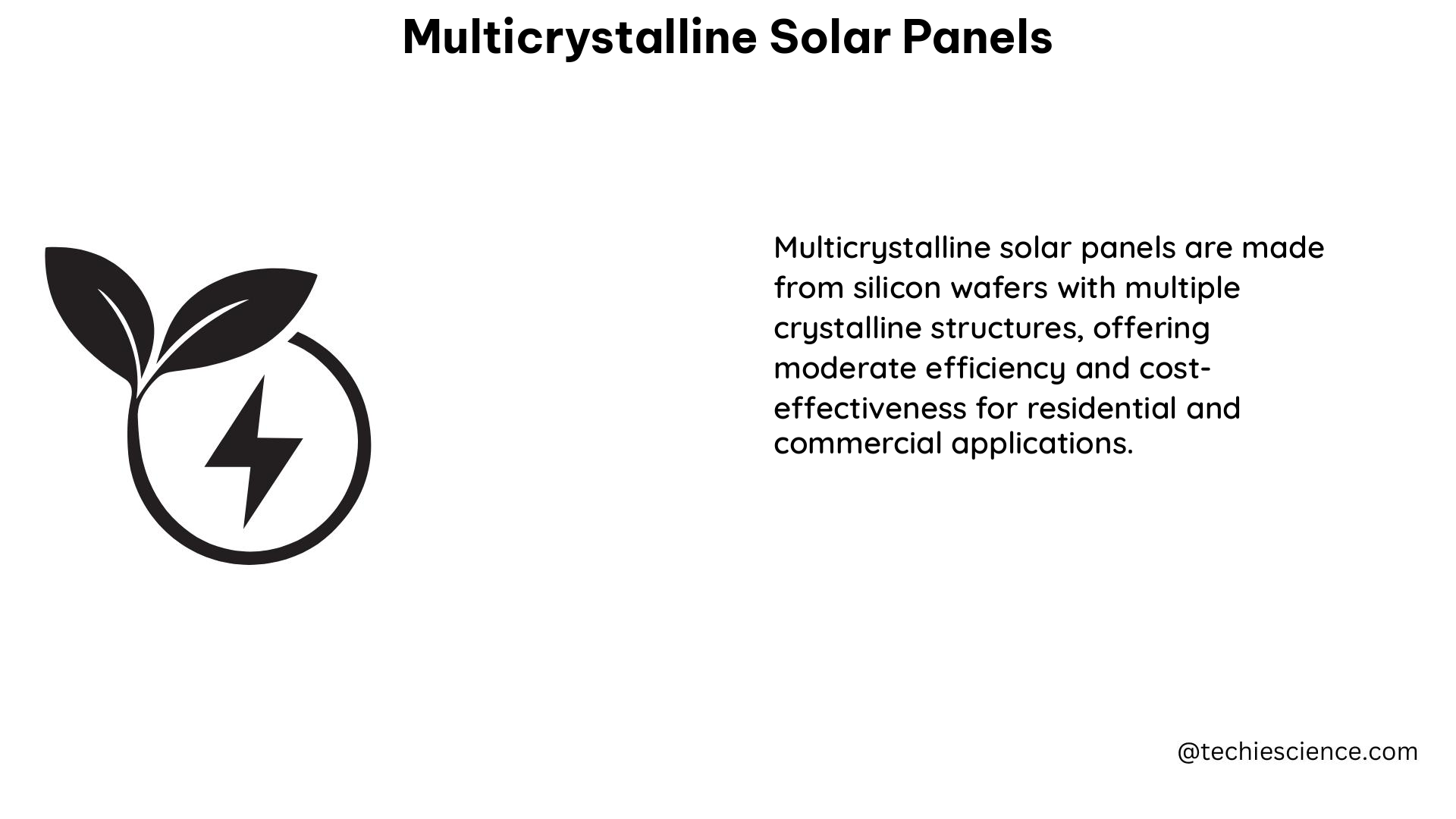Multicrystalline solar panels, also known as polycrystalline or multi-si panels, are a popular choice for residential and commercial solar energy systems. These panels are made of many silicon crystals melted together, resulting in a distinctive bluish hue and a non-uniform appearance, unlike the uniform dark squares with rounded corners of monocrystalline panels. While multicrystalline panels typically have a slightly lower efficiency range of 13% to 16%, they offer a more cost-effective solution compared to their monocrystalline counterparts.
Understanding Multicrystalline Solar Panel Efficiency
The efficiency of a solar panel is a crucial factor in determining its performance and energy output. Multicrystalline solar panels have an efficiency range of 13% to 16%, which is still considered high in the solar industry. This efficiency range is influenced by several factors, including the quality of the silicon used, the manufacturing process, and the panel’s design.
One important factor that affects the efficiency of multicrystalline solar panels is the temperature coefficient. The temperature coefficient measures how well the solar cell functions as the temperature rises. For multicrystalline panels, the temperature coefficient typically ranges from -0.3% / °C to -1% / °C. This means that for every degree Celsius increase in temperature, the panel’s efficiency will decrease by 0.3% to 1%. Most multicrystalline solar cells have a temperature coefficient of approximately -0.3% / °C to -0.5% / °C.
To calculate the efficiency of a solar panel, you can use the following formula:
Efficiency = (Panel Power (in kW) / (Panel Length x Panel Width (in m))) x 100%
This formula takes into account the panel’s power output and its physical dimensions to determine its overall efficiency.
Multicrystalline Solar Panel Lifespan and Environmental Impact

In terms of lifespan, multicrystalline solar panels have a slightly shorter lifespan compared to monocrystalline panels. While monocrystalline panels can last up to 40 years, multicrystalline panels typically have a lifespan of around 35 years. This difference is due to the manufacturing process and the quality of the silicon used in each type of panel.
However, it’s important to note that the environmental impact of multicrystalline solar panel production is a concern. A study on the life cycle assessment of multicrystalline silicon photovoltaic cell production in China revealed that this technology contributed significantly to respiratory inorganics, global warming, and non-renewable energy consumption. This highlights the need for continued research and development to improve the sustainability of multicrystalline solar panel manufacturing.
Advantages and Disadvantages of Multicrystalline Solar Panels
Advantages:
- Cost-Effective: Multicrystalline solar panels are generally more affordable than monocrystalline panels due to their simpler manufacturing process.
- Good Efficiency: While not as high as monocrystalline panels, multicrystalline panels still offer a respectable efficiency range of 13% to 16%.
- Versatile Appearance: The distinctive bluish hue and non-uniform appearance of multicrystalline panels can be aesthetically pleasing for some homeowners and businesses.
Disadvantages:
- Lower Space Efficiency: Multicrystalline panels are less space-efficient than monocrystalline panels, meaning they require more physical space to generate the same amount of power.
- Shorter Lifespan: Multicrystalline panels have a slightly shorter lifespan of around 35 years compared to the 40-year lifespan of monocrystalline panels.
- Environmental Impact: The production of multicrystalline silicon photovoltaic cells has been shown to contribute significantly to respiratory inorganics, global warming, and non-renewable energy consumption.
Choosing the Right Multicrystalline Solar Panels
When selecting multicrystalline solar panels for your solar energy system, it’s important to consider factors such as efficiency, temperature coefficient, physical dimensions, and environmental impact. Additionally, you should research the reputation and warranty offerings of the solar panel manufacturer to ensure you’re investing in a high-quality product.
By understanding the technical details and performance characteristics of multicrystalline solar panels, you can make an informed decision that aligns with your energy needs, budget, and environmental concerns.
References:
- Data Analytics in Solar Energy
- How is Solar Panel Efficiency Measured?
- System for Measuring and Collecting Data from Solar-Cell Systems
- Monocrystalline vs. Polycrystalline Solar Panels
- Life Cycle Assessment of Multicrystalline Silicon Photovoltaic Cell Production in China

The lambdageeks.com Core SME Team is a group of experienced subject matter experts from diverse scientific and technical fields including Physics, Chemistry, Technology,Electronics & Electrical Engineering, Automotive, Mechanical Engineering. Our team collaborates to create high-quality, well-researched articles on a wide range of science and technology topics for the lambdageeks.com website.
All Our Senior SME are having more than 7 Years of experience in the respective fields . They are either Working Industry Professionals or assocaited With different Universities. Refer Our Authors Page to get to know About our Core SMEs.